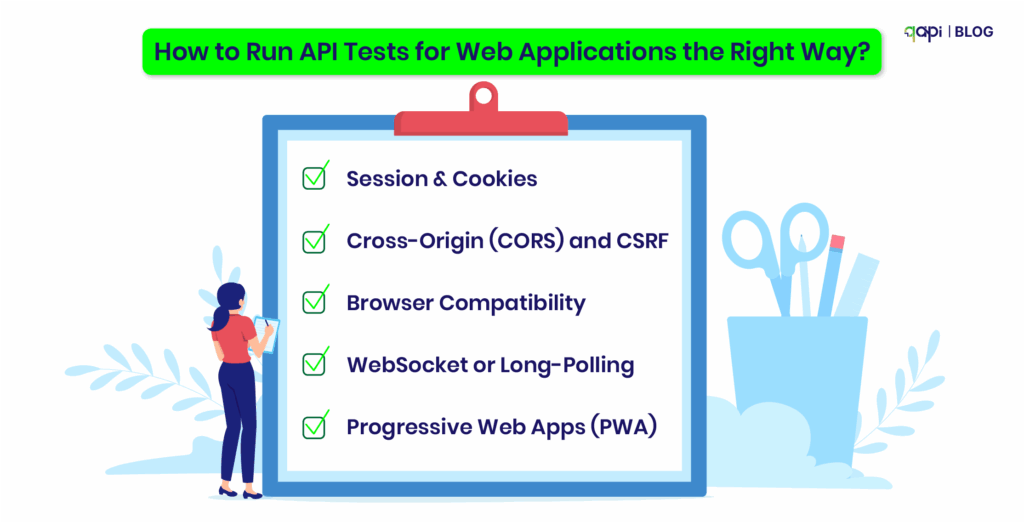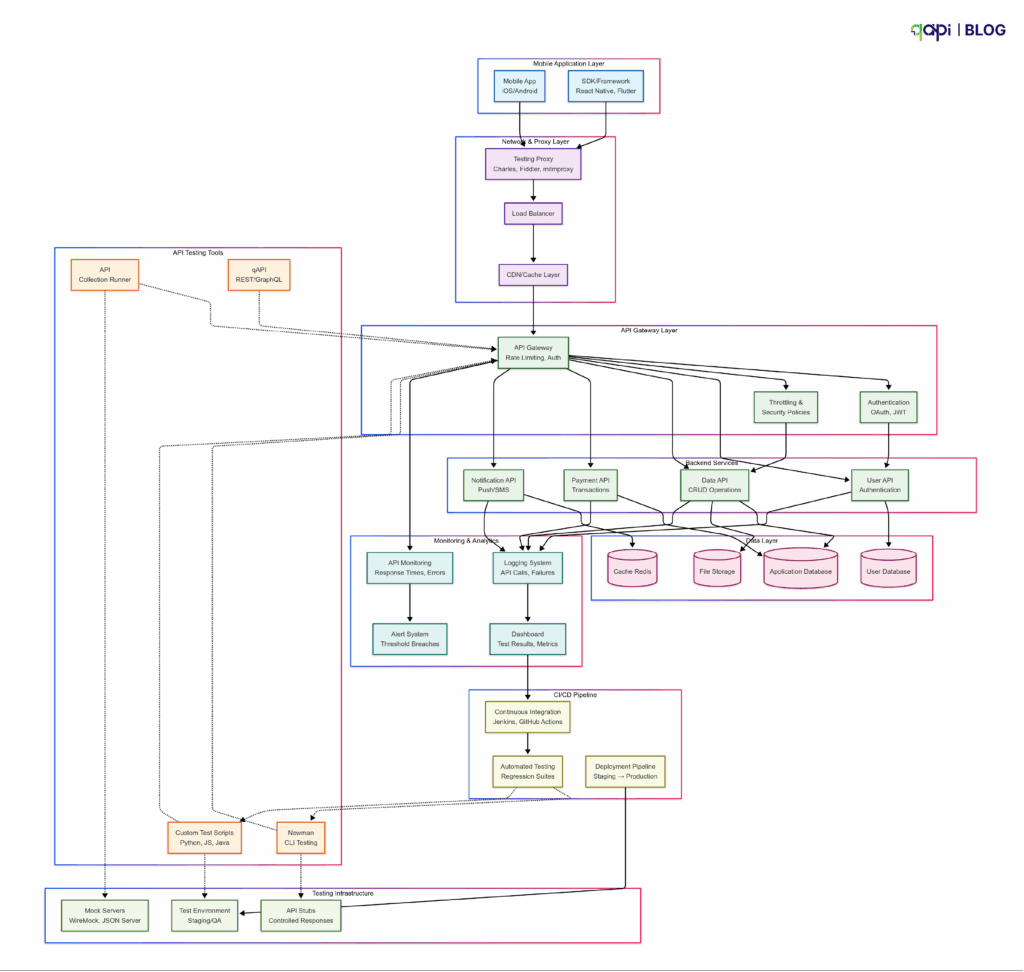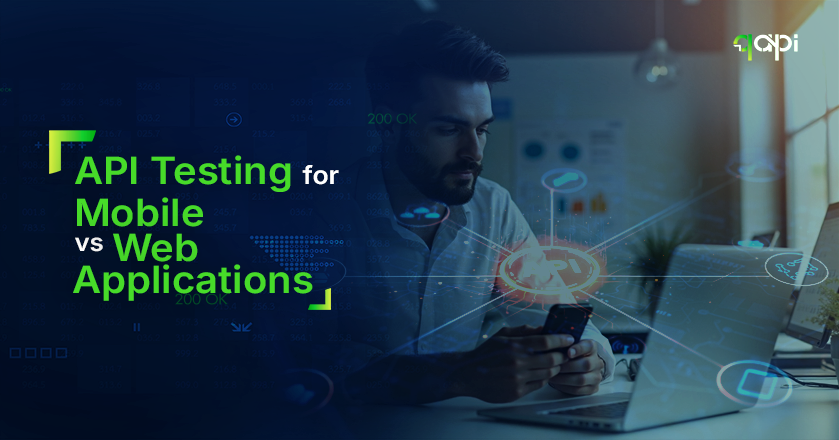APIs don’t care where they run — but you should. Because the same API that performs smoothly on a desktop browser might choke on a 3G mobile network. Or behave differently when a background refresh meets limited battery.
We are focused on building seamless digital experiences, but your APIs are the strong threads holding mobile and web apps together. And yet, most testing strategies still treat them the same — assuming what works for web will just work on mobile.
It won’t.
This blog is for developers and testers who’ve ever had to debug flaky mobile behavior, been surprised by platform-specific bugs, or wondered why an API call times out only on older Android devices. We’re going beyond the basics — into the real differences, the overlooked challenges, and how to truly test APIs the smart way, whether you’re building for the big screen or the palm of a hand.
The confusion between API testing for mobile apps vs. web apps is one of the most basic and yet overlooked issues, especially among QA teams, product owners, and even developers new to the API-first mindset. Let us understand it in detail.
What Stays the Same: The Fundamentals of API Testing
No matter where your API runs — mobile or web — the fundamentals don’t change:
✅ Endpoints need validation.
✅ Requests must be sent, received, and parsed.
✅ Responses need to be accurate, fast, and secure.
Assertions, status codes, schema validation, auth checks — these are the bedrock of every good API test suite. And that’s where most testers stop.
But when your user experience spans devices, networks, and platforms, the real testing starts where the fundamentals end.
Where Things Break: The Mobile vs. Web Reality
Testing on mobile? You’re dealing with:
✅ Unreliable networks (3G, LTE, edge drops)
✅ Background app behaviors (throttling, OS interruptions)
✅ Limited device memory and battery optimization quirks
✅ Offline-first expectations and caching strategies
Testing on web? You’re navigating:
✅ Browser compatibility, tab switching, CORS issues
✅ Faster and more stable networks
✅ Rich logging and devtools, making debugging easier
So yes, your API is the same. But the environment it interacts with isn’t. And that makes all the difference.
| Pitfall | Why It Happens | How to Catch It with qAPI |
|---|---|---|
| API Timeout on Mobile | Network or battery-induced throttling | Use qAPI’s performance test mode with simulated 3G/4G |
| Caching Conflicts | App stores stale data when offline | Run test flows with local storage/cache validation |
| Token Expiry Mid-Session | Inactive mobile apps resume after token expiry | Use session replay with auth refresh scenarios |
| Different Serialization Bugs | iOS vs. Android parse data differently | Cross-platform validation with mobile SDK mocks |
Dev Tester Tip:
In qAPI, you can group mobile and web test cases into separate collections, apply environment-specific settings, and run parallel tests — all without writing a single line of code.
Where Do People Get It Wrong
The biggest mistake teams make is assuming the same test coverage or strategy works across both platforms.
✅ Web testers often miss out on referencing real-world mobile conditions like packet loss, delayed sync, or interrupted sessions.
✅ Mobile teams sometimes overlook full-scale integration validation assuming the frontend (app) can handle it.
Think of a car engine vs. a motorcycle engine. (We know you’re not a mechanic but still!)
Both use internal combustion and serve the same purpose — powering movement. But they require different cooling systems, fuel ratios, and maintenance routines.
Likewise, API testing shares the same base logic, but its execution — especially under real-world conditions — depends on whether it’s delivering a web or a mobile experience.
API Testing for Web Applications
Web API Architecture
Web applications rely on APIs to connect front-end interfaces with back-end servers, using protocols like HTTP/REST. They power e-commerce, streaming, and more, often needing robust testing, completely straightforward.
Let’s break it down step by step:
What Is API Testing for Web Applications?
API testing checks if the APIs in your web application is doing their designated jobs properly. It’s not just about making sure they work—it’s about confirming they work well under all kinds of conditions. Here’s what it typically involves:
✅ Functional Testing: Does the API give the right response? For example, if a user searches for “blue shoes,” does the API return a list of blue shoes and not red hats?
✅ Security Testing: Are the APIs safe from hackers? This includes checking for things like weak endpoints, authentication or data leaks.
✅ Performance Testing: Can the API handle lots of users at once—like during a big sale—without endlessly loading or crashing?
✅ Integration Testing: Do the APIs play nicely with other systems, like databases or third-party tools?
Why Does API Testing for Web Applications Matter?
✅ Reliability: If an API fails, your app might not load data, process orders, or even log users in. Testing keeps things running smoothly and ready for any condition.
✅ Security: APIs are the most focussed targets for cyberattacks. A good test can spot vulnerabilities before they become a problem.
✅ Performance: Slow APIs mean slow web pages. Users won’t wait around—testing ensures your app stays responsive, say goodbye to growth.
✅ Growth: As more people use your app, APIs must be capable enough to handle the additional load as and when required. Testing confirms they’re ready to scale.
How to Run API Tests for Web Applications the Right Way?
Session & Cookies – Web apps use cookies or tokens (like JWTs) to keep users logged in and track their sessions. These need to be properly secured—using flags like Secure and HttpOnly—to prevent attackers from stealing them.
Good API testing standard to have is to check that- login works correctly, sessions expire as expected, and logout stops access. Without this, users may stay logged in too long or attackers might reuse session data.
For example, after logging in on a web site, the following API calls should include a valid session cookie. Verify that logging out invalidates the cookie and subsequent calls fail.
Cross-Origin (CORS) and CSRF – Web apps are subject to same-origin policy. Ensure the API includes appropriate CORS headers (e.g. Access-Control-Allow-Origin) to allow the web front-end’s domain. Test that the API only allows trusted origins.
Similarly, if your app uses cookies for login, it needs protection against CSRF (Cross-Site Request Forgery), where attackers trick users into sending fake requests. API testing here ensures only trusted websites get access, and that every sensitive request has CSRF protection in place.
Browser Compatibility – While most of this affects front-end, some APIs behave differently depending on the browser (e.g. variations in HTTP keep-alive, caching).
Testing APIs across browsers like Chrome, Safari, and Firefox helps catch bugs that only show up in specific environments. It ensures a consistent and error-free experience for all users, no matter what browser they use.

WebSocket or Long-Polling – If your web app uses WebSockets or server-related events, include those in your API tests (this is less common in mobile). For example, test that a chat message sent via WebSocket results in the correct API event.
If these break, users may miss updates or messages. Therefore, we recommended that API tests should check for connection stability, message delivery, and how the system handles disconnects or large numbers of users.
Progressive Web Apps (PWA) – If the web app is a PWA with offline service workers, make it a priority to test those capabilities separately. These workers store API responses for later use, which is great for poor network conditions—but only if done right.
API testing should make sure data is cached correctly, updates are fetched when back online, and errors are handled gracefully if the network is down. For example, simulate offline use and ensure the service worker still returns cached API data correctly.
Test cache updates: Go online, make an API call, and ensure the service worker updates its cache with the latest data.
Verify error handling: Try an API call that requires a network (e.g., posting new data) while offline—it should show a user-friendly error or queue the request for later.
Challenges in Web API Testing
Testing APIs for web applications comes with some unique challenges:
✅ Browser Compatibility Issues: As mentioned earlier, different browsers and their versions may interpret and execute web standards differently. APIs need to ensure compatibility with major browsers and their versions.
Testing must cover multiple browsers and versions to identify and resolve compatibility issues, ensuring consistent API functionality and performance.
✅ State Management Complexity: Web applications typically adopt a stateless design, but user interactions often require maintaining state information. APIs need to handle state management effectively, such as through cookies or session storage.
However, state management can introduce complexities like session expiration and data consistency issues. Testing must ensure accurate state management and seamless user experiences.
✅ Security Threats: Web applications are exposed to a wide range of security threats, such as SQL injection, XSS attacks, and CSRF attacks. APIs, as the entry point for data transmission, are vulnerable targets.
Your testing plans must adopt advanced security testing techniques and tools to identify and fix security vulnerabilities, ensuring API security and compliance with relevant standards.
✅ User Sessions: Web apps often track what users are doing (like items in a shopping cart). APIs must handle this session data correctly, which can get complicated.
✅ Real-Time Updates: Many web apps use APIs for instant updates—like new messages in a chat app. Testing these fast, asynchronous requests takes extra care.
Best Practices for Web App API Testing
✅ Understand API Requirements and Specifications: Review API documentation and specifications to understand endpoints, methods, request/response formats, authentication, and error codes.
Maintain and version API specs for clarity and collaboration
✅ Functional Testing: Validate your endpoints with qAPI. Write test cases for every API endpoint. Check normal scenarios (like a typical login) and weird ones (like entering a 500-character password).
✅ Performance Testing: Use qAPI for load testing (e.g., 500ms response time target).
✅ Security Testing: Test OAuth and SSL with OWASP ZAP.
✅ Validate Responses and Status Codes: Assert correct HTTP status codes for all scenarios (e.g., 200, 400, 404, 401).
Verify response data, structure, and types for accuracy.
✅ Integration Testing: Ensure seamless database and third-party integration.
API Testing for Mobile Applications
Mobile API Architecture
These tests ensures that you let your mobile app request data (like a restaurant menu), send updates (like an order confirmation), or trigger actions (like a payment). Testing them ensures they’re reliable, fast, and secure.

For mobile apps, API testing checks should confirm
✅ Functionality: Does the API return the right data? For example, if a user searches for “pizza,” does it list pizza places?
✅ Performance: Is the API quick enough, even on a slow network?
✅ Security: Are user details safe from hackers?
✅ Offline Behavior: Can the app handle no internet by caching data?
Mobile-Specific API testing Challenges
Unlike web apps, mobile apps operate in a completely different environment. Here although the users might be same but their requirements are different:
✅ Offline Mode: Many apps must work without internet and must be able to automatically sync data later. 70% of users expect apps to work offline, and apps with offline features have up to 3x higher user retention.
✅ Network Environment Complexity: Mobile devices connect to the internet via various network types such as 4G, 5G, WiFi, and Bluetooth. Network conditions can be unstable and vary significantly.
In such cases APIs must ensure reliable data transmission and accurate responses under different network environments. The testing metrics needs to recreate scenarios like switching between networks, poor network connectivity, and high latency to validate API performance and stability.
✅ Device Hardware Differences: Device Fragmentation: Thousands of devices (iPhones, Androids) with different screens, hardware, and OS versions (iOS 17, Android 14, etc.) mean APIs must be compatible across the board.
The testing requires coverage of devices with varying hardware configurations to ensure API performance remains the same across all variants.
✅ OS Version Fragmentation: Mobile operating systems have numerous versions in use simultaneously. For example, Android has many active devices running different versions.
APIs must ensure compatibility and stability across different OS versions. Testing must cover major OS versions to identify and resolve potential issues.
✅ Application Background Execution Restrictions: To save battery life and system resources, mobile operating systems impose restrictions on background app execution.
APIs may face limitations on network requests and data synchronization when the app is in the background. There are instances where testing teams fail to check whether APIs can handle such restrictions properly and ensure data consistency and functionality.
Best Practices for Mobile API Testing
✅ Use Real Devices and Emulators: Test on actual phones (e.g., Samsung Galaxy, iPhone) and emulators to cover diverse scenarios. Tools like Qyrus can help.
For example, ensure an API call works the same on both Android and iOS, and on an old Android vs. the latest. Differences in TLS support or JSON parsing between OS versions can affect API handling.
✅ Simulate Networks: Recreate real-world conditions—slow 3G, unstable 4G, or offline. Test that APIs return cached data or queue requests when offline and retry smoothly when connection restores.
✅ Focus on Security: Use strong encryption and authentication (e.g., OAuth). Test for leaks or vulnerabilities.
✅ Test Offline Functionality: Ensure the app caches data and syncs smoothly when back online.
✅ Improve Performance: Test multiple scenarios by forcing the app into background and triggering the API (for example, send a push notification to trigger background data sync). Ensure these APIs behave correctly (respect app sleep mode, don’t drain battery) and data is saved for when the app resumes.
✅ Automate Testing: Manual tests take too long—use qAPI to automate across devices and platforms.
Now Let Us Look at the
Approach one should have when testing APIs whether for Mobile and Web applications
Versioning and Backward Compatibility
Mobile apps often lag in updates, requiring APIs to support older versions for months or years. Web apps can sync UI and API updates, simplifying versioning.
Use URL-based versioning (e.g., /v1/login) and maintain old test suites for mobile clients. Automate compatibility tests before deprecating versions.
Version Control for Tests – Store your test scripts/collections in the same repository as code or in a shared repo. Treat them as code: review and update tests with feature changes.
Shift Left and Automate Early – We live on this statement “Get started with API testing early in development to catch bugs before the UI is built”. Write automated tests alongside code changes.
Integrate these into your CI/CD pipeline so that tests run on every build or pull request. For example, run a collection from postman or any other tool or execute your test suite on qAPI with ease.
Isolate Test Data and Environments – Keep separate endpoints/config for dev, QA, staging, and prod. Use environment variables in your tools to switch contexts without changing scripts. Reset or seed test data between runs to ensure consistency.
Meaningful Assertions and Logging – In automated tests, assert not just status codes but also key response content. Log detailed info (request URL, request body, full response) on failure to aid debugging.
Performance Tests in Pipeline – Include smoke performance tests (e.g. basic load) in CI or nightly jobs. For mobile, incorporate testing at various simulated network speeds as part of continuous testing.
Code Reuse and Modular Tests – Use shared functions or libraries to build API requests (e.g. a method to get an auth token). This makes tests easier to maintain.
Monitor Production APIs – Even after deployment, keep monitoring (uptime, latency, errors). Alerts on anomalies can trigger additional testing or rollbacks.
Documentation Updates – Update API documentation with any changes and keep it versioned. Good docs help testers know what to expect. You need documentation more than you realize.
Handle Platform Nuances – In CI, consider platform differences: run your test suite on both a Linux host (for web) and on mobile simulators/emulators (for mobile-specific scenarios). Use cloud device farms for wide coverage if needed.
Regular Review and Refinement – API testing is ongoing. As the API evolves, refactor tests, add new cases for new features, and prune obsolete ones. Use test results to continuously improve both the API and the testing process
Mobile vs Web API testing: What’s Actually Different?
To summarize it
| Aspect | Mobile API Testing | Web API Testing |
|---|---|---|
| Network Conditions | Varies drastically —2G, 3G, 5G, airplane mode | Usually stable, high-speed broadband or WiFi |
| Latency Sensitivity | Very high — even a 100ms delay impacts UX | More tolerant due to fewer bandwidth constraints |
| Payload Optimization | Critical — to reduce battery/data usage | Less strict — larger payloads are acceptable |
| Caching & Offline Modes | Often required — apps need to function with poor/no connectivity | Rarely used or handled by browsers |
| Client-Side Storage | Devices rely on local storage (e.g. SQLite) + sync via APIs | Typically handled server-side or via cookies/session |
| Testing Constraints | Must simulate real device scenarios (background apps, interruptions, throttling) | Fewer edge cases in environment variability |
How does API rate limiting impact mobile app testing differently than web application testing?
Rate limiting is how APIs prevent abuse by limiting how many requests a client can make in a given timeframe. Web apps typically make requests when users interact with the browser. In contrast, mobile apps sync data in the background, retry failed requests after connectivity returns, and sometimes queue requests when offline.
This leads to unstable traffic patterns that can trigger rate limits — especially after a device reconnects to the internet.
Testing Tip: Simulate offline-to-online transitions and retry queues to test how gracefully your app handles 429 Too Many Requests responses. Tools like qAPI, Postman Runner, k6, and JMeter are helpful here.
What unique security challenges arise in API testing for mobile apps compared to web apps?
Mobile apps face device-level threats that web apps do not:
✅ Tokens might be stored insecurely in local storage.
✅ Apps can be reverse-engineered to discover API keys or endpoints.
✅ Mobile devices are more likely to connect to insecure Wi-Fi networks.
Meanwhile, web apps are more susceptible to browser-specific risks like XSS and CSRF.
Testing Tip: Validate token handling and session timeouts across both platforms. For mobile, use tools like OWASP ZAP or Burp Suite to inspect traffic, even when encrypted (via SSL stripping especially on\ test devices).
What are the best practices for testing APIs that serve both mobile and web clients with different data formats or endpoints?
Some APIs are designed to serve platform-specific payloads:
✅ Mobile might get compressed, minimal responses.
✅ Web might receive more verbose or interactive data.
Also, auth flows might differ. For instance, mobile often uses OAuth2 with refresh tokens, while web apps may rely on session cookies.
Testing Tip:
✅ Tag test cases by platform.
✅ Validate content negotiation (Accept headers).
✅ Ensure old mobile apps don’t break when new data formats are introduced.
How to handle versioning and backward compatibility in API testing for mobile apps vs web apps?
Mobile users don’t always update apps right away. So your backend may need to support older versions of the API for months or years.
In contrast, web apps can push UI and API updates in sync — so versioning is less painful.
Testing Tip:
✅ Use headers or URL-based versioning (e.g. /v1/login)
✅ Keep old test suites active for older mobile clients
✅ Automate compatibility testing before deprecating versions
What are the differences in automating API tests for mobile vs. web apps in CI/CD pipelines?
Automating API testing is essential in DevOps — but mobile adds complexity:
✅ Tests must run across emulators and devices
✅ Push notifications or background jobs can be hard to automate
✅ Flaky network or permission issues introduce false positives
Use a codefree tool to automate testing across environments.
What role does compliance testing play in mobile API testing versus web API testing?
If your app collects user data — especially in fintech, healthcare, or education — your API tests should include compliance checks.
Mobile apps raise additional concerns:
✅ GPS, photos, and biometric data handling
✅ Device-level encryption
✅ Persistent storage risks (SQLite, shared preferences)
Testing Tip: Test that PII and health data are encrypted in transit (HTTPS), and never stored insecurely. Run vulnerability scans for all the exposed endpoints.
Next Steps
Building the right API testing strategy for mobile and web applications will give you the reliability, security, and performance across platforms. By addressing mobile-specific challenges like device fragmentation and network variability, and web-specific issues you can deliver seamless user experiences.
Think about it: mobile apps have to juggle device diversity, unpredictable networks, and background tasks like push notifications. Meanwhile, web apps face their own hurdles-cross-browser quirks, server scalability, and ever-evolving security threats like XSS. But no matter the platform, the foundation is the same: smart API testing that’s both thorough and adaptable.
Why does this matter so much? Because APIs now power major chunk of all app interactions. And the companies leading the pack know it. Just look at DoorDash, which slashed mobile API latency by 50% to keep deliveries on track, or Shopify, which scaled its web APIs to handle over a million calls every single day. Their secret? A proactive, automation-first approach to API testing.
Embrace AI-driven test generation-expected to automate 60% of tests by 2028. And get ready for 5G’s ultra-low latency, which will set new standards for mobile API responsiveness (Ericsson).
If you’re looking for a deeper dive, download our comprehensive eBook, Mastering API-First Strategies: Lessons from Big Tech.
Discover how leaders like Amazon, Netflix, and DoorDash build API-first ecosystems-leveraging automation, mocking, and compliance testing to scale with confidence. Get your copy now for practical guides, expert tips, and actionable checklists tailored for both developers and testers.
Don’t let untested APIs hold your app back. Start optimizing your API testing process, align with proven best practices, and deliver the kind of digital experiences your users will rave about. The future of your product starts with smarter testing-take the first step today.

